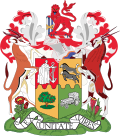Cape Province
 From Wikipedia - Reading time: 8 min
From Wikipedia - Reading time: 8 min
| Province of the Cape of Good Hope Provinsie Kaap die Goeie Hoop (Afrikaans) | |||||||||||||||
|---|---|---|---|---|---|---|---|---|---|---|---|---|---|---|---|
| Province of South Africa | |||||||||||||||
| 1910–1994 | |||||||||||||||
 The Cape Province as it was by 1994 | |||||||||||||||
| Capital | Cape Town | ||||||||||||||
| Population | |||||||||||||||
• 1991 | 6,125,335[1] | ||||||||||||||
| • Type | Cape Provincial Council | ||||||||||||||
| History | |||||||||||||||
• Established | 31 May 1910 | ||||||||||||||
• Disestablished | 27 April 1994 | ||||||||||||||
| |||||||||||||||
The Province of the Cape of Good Hope[2] (Afrikaans: Provinsie Kaap die Goeie Hoop), commonly referred to as the Cape Province (Afrikaans: Kaapprovinsie) and colloquially as The Cape (Afrikaans: Die Kaap), was a province in the Union of South Africa and subsequently the Republic of South Africa. It encompassed the old Cape Colony, as well as Walvis Bay, and had Cape Town as its capital. In 1994, the Cape Province was divided into the new Eastern Cape, Northern Cape and Western Cape provinces, along with part of the North West.
History
[edit]When the Union of South Africa was formed in 1910, the original Cape Colony was renamed the Cape Province.
It was by far the largest of South Africa's four provinces, as it contained regions it had previously annexed, such as British Bechuanaland (not to be confused with the Bechuanaland Protectorate, now Botswana), Griqualand East (the area around Kokstad) and Griqualand West (area around Kimberley). As a result, it encompassed two-thirds of South Africa's territory, and covered an area of approximately 717,000 square kilometres (277,000 sq mi).
At the time of the formation of the Union of South Africa, South Africa consisted of four provinces: Transvaal (previously the South African Republic), Natal, Orange Free State and the Cape Province.
Cape Franchise
[edit]Before union, the Cape Colony had traditionally implemented a system of non-racial franchise, whereby qualifications for suffrage were applied equally to all males, regardless of race. During the union negotiations, the Cape Prime Minister, John X. Merriman fought unsuccessfully to extend this multi-racial franchise system to the rest of South Africa. This failed, as it was strongly opposed by the former Boer Republics which were determined to entrench white rule. After union, the Cape Province was permitted to keep a restricted version of its multi-racial qualified franchise, and thus became the only province where Coloureds (mixed-race people) and Black Africans could vote.[3][4]
Over the following years, successive acts were passed to erode this colour-blind voters roll. In 1931, the restricting franchise qualifications were removed for white voters, but kept for Black and Coloured voters.[5] In 1956, the Apartheid government removed all remaining suffrage rights for "non-whites". The government had to appoint many extra senators in parliament to force through this change.[6]
Partitioning under Apartheid
[edit]During the apartheid era, so-called "bantustans" or homelands for the different Bantu nations were carved out of the existing provinces as part of the policy of perpetuating white control over South Africa. These became known as the four independent TBVC States and the six Non-Independent Homelands.[citation needed]
In the Cape Province, the Transkei (1976) and Ciskei (1981) regions were declared independent of South Africa.[7] Griqualand East was transferred to Natal Province after Transkei was declared independent, since it was cut off from the rest of the province. With the 1994 adoption of the Interim Constitution, these homelands were re-incorporated into South Africa,[7] both part of the new Eastern Cape province.
Post-apartheid
[edit]After the first fully democratic elections in April 1994, the Transkei and Ciskei bantustans were reunited with Cape Province, then the country was divided into what are now the current nine provinces of South Africa. Cape Province was broken up into three smaller provinces: the Western Cape, Eastern Cape and Northern Cape. Parts of it were also absorbed into the North West. Walvis Bay, a territory of the original Cape Colony, had been ceded to Namibia two months earlier.
Districts in 1991
[edit]Districts of the province and population at the 1991 census.[1]
Administrators
[edit]See also
[edit]References
[edit]- ^ a b "Census > 1991 > RSA > Variable Description > Person file > District code". Statistics South Africa – Nesstar WebView. Archived from the original on 19 June 2016. Retrieved 18 August 2013.
- ^ South Africa Act, 1909 §6 (Wikisource)
- ^ "EISA South Africa: White domination and Black resistance (1881-1948)". Archived from the original on 4 June 2012. Retrieved 25 June 2012.
- ^ "Archived copy" (PDF). Archived from the original (PDF) on 17 May 2006. Retrieved 6 July 2012.
{{cite web}}: CS1 maint: archived copy as title (link) - ^ "EISA South Africa: Historical franchise arrangements". Archived from the original on 9 May 2013. Retrieved 25 June 2012.
- ^ Christoph Marx: Oxwagon Sentinel: Radical Afrikaner Nationalism and the History of the Ossewabrandwag. LIT Verlag Münster, 2009. p.61.
- ^ a b "The Homelands". South African History Online. Retrieved 31 December 2017.
- ^ "Dictionary of Southern African Place Names (Public Domain)". Human Science Research Council. p. 182.
- ^ "Dictionary of Southern African Place Names (Public Domain)". Human Science Research Council. p. 200.
- ^ "Dictionary of Southern African Place Names (Public Domain)". Human Science Research Council. p. 205.
- ^ "Dictionary of Southern African Place Names (Public Domain)". Human Science Research Council. p. 478.
External links
[edit]- A history of the Cape Province
- Archives kept at Cape Town Archived 22 April 2021 at the Wayback Machine
- Cana, Frank Richardson; Gibson, Walcot; Hillier, Alfred Peter (1911). . Encyclopædia Britannica. Vol. 5 (11th ed.). pp. 225–248.
- Cana, Frank Richardson (1922). . Encyclopædia Britannica. Vol. 30 (12th ed.). pp. 563–564.
 KSF
KSF
